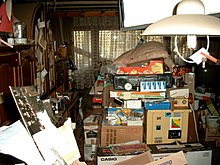Hoarding: Difference between revisions
| Line 18: | Line 18: | ||
{{main|Compulsive hoarding}} |
{{main|Compulsive hoarding}} |
||
[[File: Compulsive hoarding Apartment.jpg|thumb|Apartment of a person with compulsive hoarding]] |
[[File: Compulsive hoarding Apartment.jpg|thumb|Apartment of a person with compulsive hoarding]] |
||
Some hoarding in [[human]]s may be a form of mental illness, specifically [[obsessive–compulsive disorder]],<ref>[http://www.mayoclinic.com/health/hoarding/DS00966 Mayo Clinic hoarding definition]</ref> where the perceived importance of the hoarded items far exceeds their true value.<ref>[http://www.harthosp.org/InstituteOfLiving/AnxietyDisordersCenter/CompulsiveHoarding/default.aspx Anxiety Disorders Center/Center for Cognitive Behavioral Therapy: Compulsive Hoarding], [[Hartford Hospital]]</ref> In severe cases, houses belonging to such people may become a fire hazard (due to blocked exits and stacked papers) or a health hazard (due to vermin infestation, excreta and detritus from excessive pets, hoarded food and garbage or the risk of stacks of items collapsing on the occupants and blocking exit routes). |
Some hoarding in [[human]]s may be a form of mental illness, specifically [[obsessive–compulsive disorder]],<ref>[http://www.mayoclinic.com/health/hoarding/DS00966 Mayo Clinic hoarding definition]</ref> where the perceived importance of the hoarded items far exceeds their true value.<ref>[http://www.harthosp.org/InstituteOfLiving/AnxietyDisordersCenter/CompulsiveHoarding/default.aspx Anxiety Disorders Center/Center for Cognitive Behavioral Therapy: Compulsive Hoarding], [[Hartford Hospital]]</ref> In other cases humans lose desire to throw away uneeded items because of a feeling of attachment to these items. In severe cases, houses belonging to such people may become a fire hazard (due to blocked exits and stacked papers) or a health hazard (due to vermin infestation, excreta and detritus from excessive pets, hoarded food and garbage or the risk of stacks of items collapsing on the occupants and blocking exit routes). |
||
==See also== |
==See also== |
||
Revision as of 21:16, 19 November 2012

Hoarding is a general term for a behavior that leads people or animals to accumulate food or other items during periods of scarcity.
Animal behavior
Hoarding and caching are common behaviors in many bird species as well as in rodents. Most animal caches are of food. However, some birds will also stingily collect other items, especially if the birds are pets. Magpies are famous for hoarding items such as money and jewelry, although research suggests they are no more attracted to shiny things than other kinds of items.
Human hoarding
Civil unrest or natural disaster may lead people to hoard foodstuffs, water, gasoline and other essentials which they believe, rightly or wrongly, will soon be in short supply. Survivalists, also known as preppers, often stockpile large supplies of these items in anticipation of a large scale disaster event.
Mental illness

Some hoarding in humans may be a form of mental illness, specifically obsessive–compulsive disorder,[1] where the perceived importance of the hoarded items far exceeds their true value.[2] In other cases humans lose desire to throw away uneeded items because of a feeling of attachment to these items. In severe cases, houses belonging to such people may become a fire hazard (due to blocked exits and stacked papers) or a health hazard (due to vermin infestation, excreta and detritus from excessive pets, hoarded food and garbage or the risk of stacks of items collapsing on the occupants and blocking exit routes).
See also
- Hoard (archaeological)
- Hoarding (economics)
- Compulsive hoarding
- Collyer brothers—rich eccentrics, famous for compulsive hoarding
- Plyushkin—fictional Russian hoarder
References
Further reading
- Tolin, David; Frost, Randy; Steketee, Gail (2007). Buried in Treasures: Help for Acquiring, Saving, and Hoarding. Oxford: Oxford University Press. ISBN 978-0-19-530058-1.
{{cite book}}: CS1 maint: multiple names: authors list (link) - Neziroglu, Fugen; Bubrick, Jerome; Yaryura-Tobias, Jose (2004). Overcoming Compulsive Hoarding: Why You Save & How You Can Stop. California: New Harbinger. ISBN 978-1-57224-349-1.
{{cite book}}: CS1 maint: multiple names: authors list (link) - Steketee, Gail; Frost, Randy (2006). Compulsive Hoarding and Acquiring: Workbook. Oxford: Oxford University Press. ISBN 978-0-19-531055-9.
{{cite book}}: CS1 maint: multiple names: authors list (link) - Steketee, Gail; Frost, Randy (2006). Compulsive Hoarding and Acquiring: Therapist Guide. Oxford: Oxford University Press. ISBN 978-0-19-530025-3.
{{cite book}}: CS1 maint: multiple names: authors list (link)
External links
- Boston University School of Social Work
- "If I Were A Hoarder" , the daughter of a compulsive hoarder writes about hoarding.
